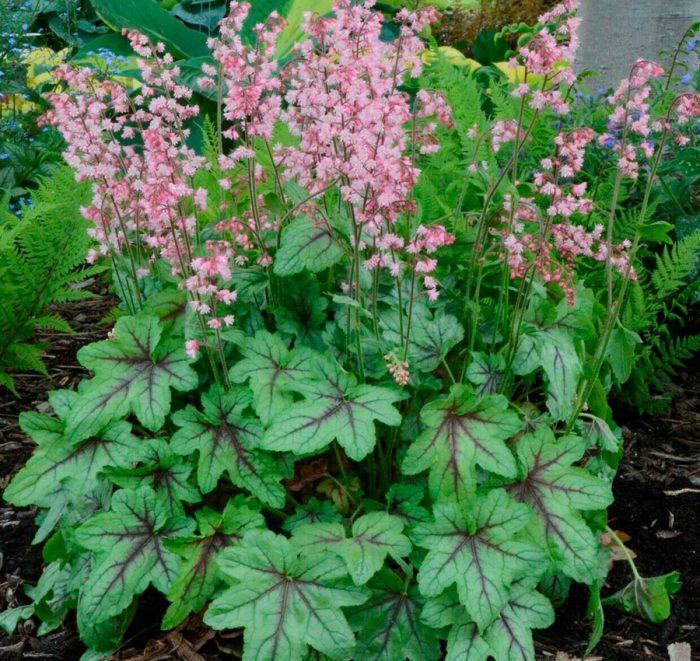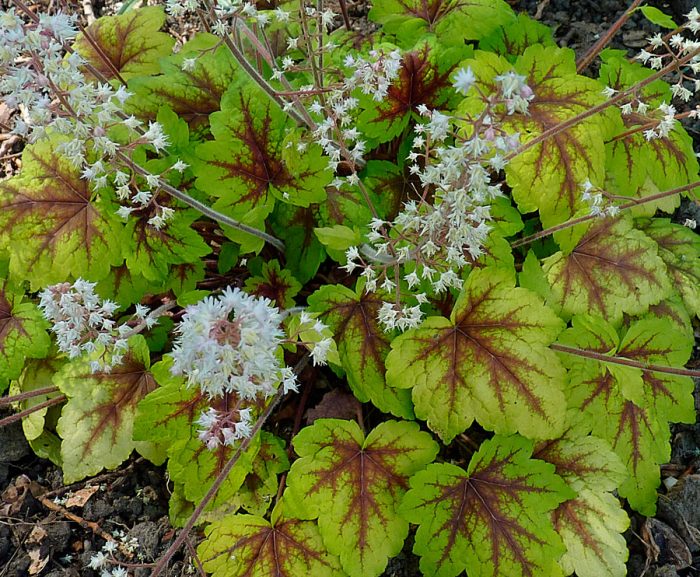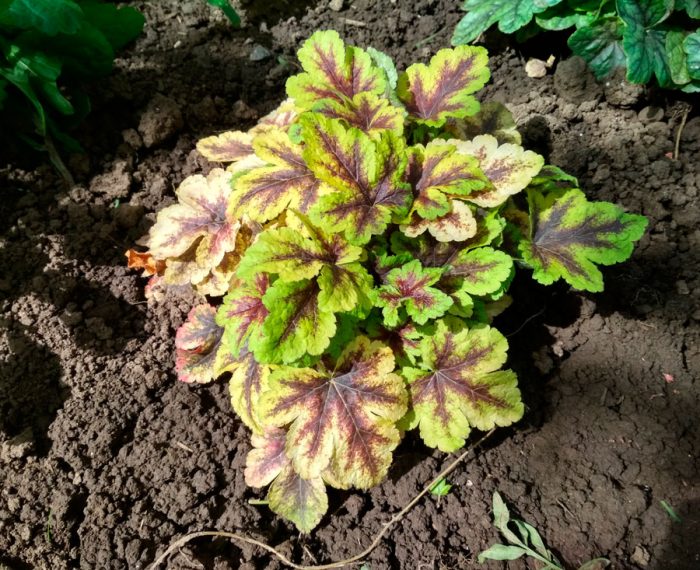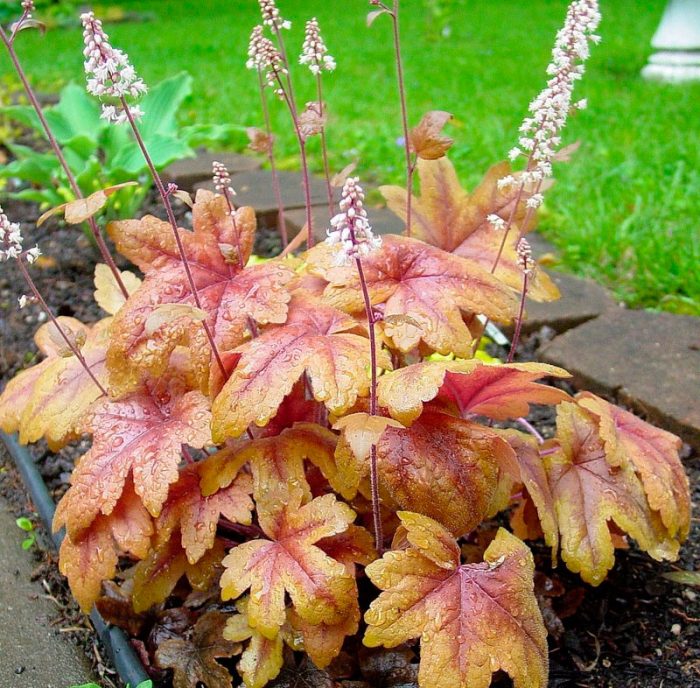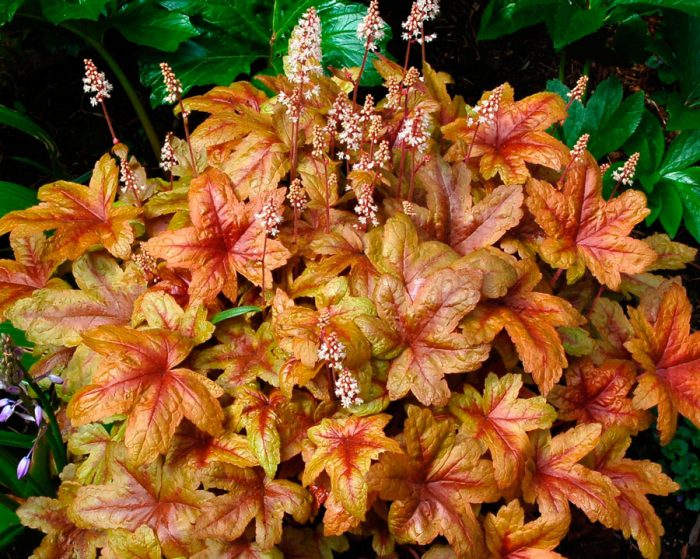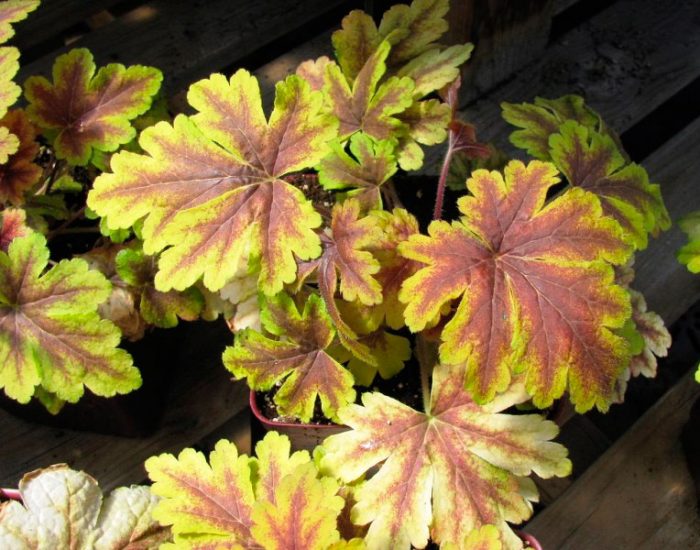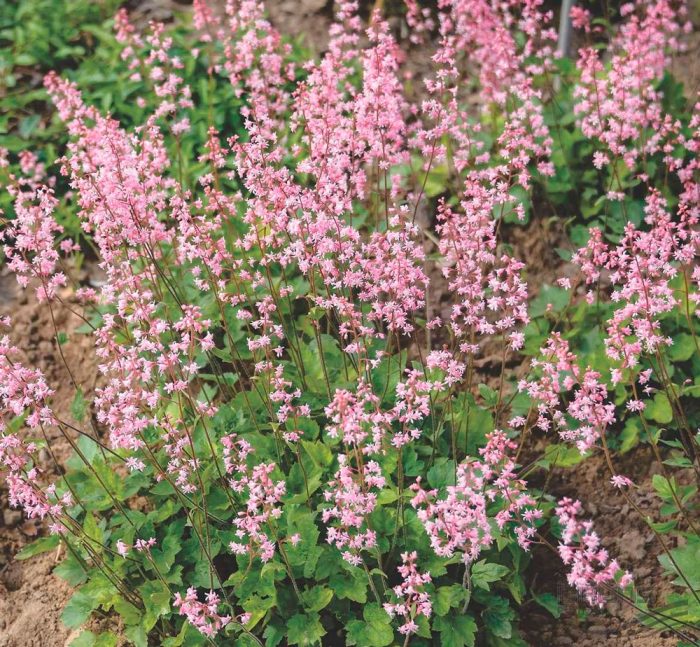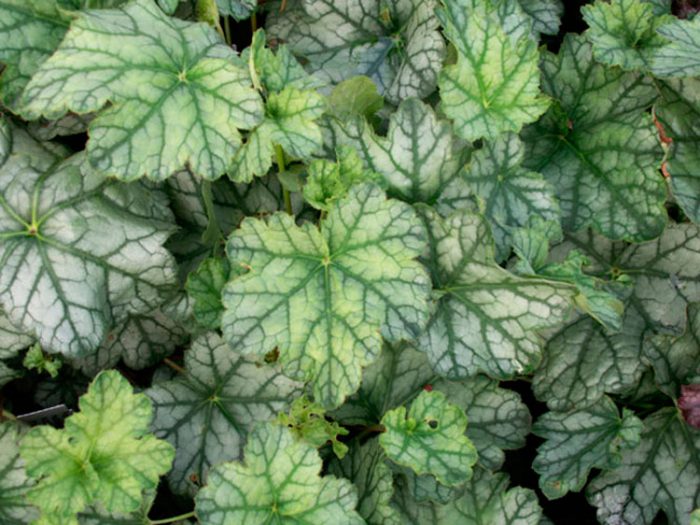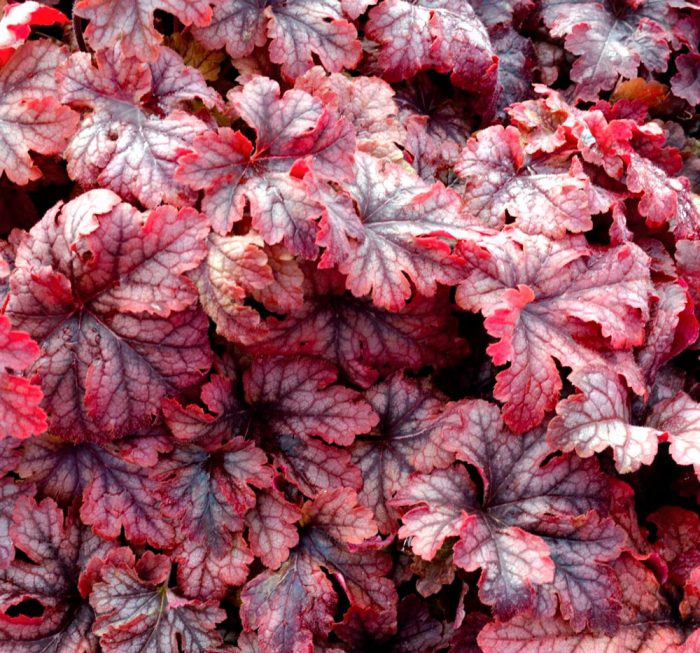The heycherella plant was obtained artificially, so it is simply impossible to meet it in natural conditions. The breeders who created it wanted to breed a very beautiful plant, ideal for landscaping. And they did it.
Content
Features of Heykherella
The Heycherell hybrid is a perennial. It was bred by crossing Heuchera and Tiarella. This herbaceous crop is intended for outdoor cultivation. Its superficial root system consists of thick roots. Its shoots are very flexible, and the long-peaked foliage is highly decorative. The leaf petioles, as well as the lower part of the leaves, are covered with dense pubescence.
The leaf plates have a dissected shape, which makes them very similar to maple foliage. In some species, small flowers of a light color are formed in the summer. The average height of such a plant is about 50 cm. The highest height of Heycherella is about 0.7 m, but this is together with paniculate inflorescences that rise above the foliage.
This culture is widely used by both gardeners and designers when creating flower ensembles or borders.
Such a flower is unpretentious:
- it grows well both in shade and in sunny areas;
- its foliage remains very bright and beautiful until the very frost;
- under a layer of snow, the plant is not harmed by frosts up to minus 40 degrees;
- tolerates drought well, but only for a short time;
- does not need special care;
- responds well to moderate feeding (begins to grow faster).
Planting heycherella in open ground
Geykhera was used to create geykherella and gave it some specific features. For example, Heycherella prefers to grow on neutral or slightly alkaline soil. She also reacts very negatively to stagnant water in the roots.
In middle latitudes, before planting such a plant, the soil on the site is mixed with dolomite flour. A drainage layer 30–50 mm thick is poured into the bottom of the prepared pits. It is also recommended to pour one handful of wood ash into each hole, which will play the role of a complex mineral fertilizer. After the seedling is placed in the hole, all voids are filled with loose soil.In doing so, remember that the central kidney must always remain open. 1 m2 plot can be grown no more than 12 bushes.
Heycherella grows well both in shade and in sunny areas. However, experienced gardeners recommend choosing a place for planting such a plant, taking into account the characteristics of a particular variety. For example, bushes with raspberry or green leafy plates grow best in shading. But in sunny areas, varieties with a delicate foliage color (for example, silver) feel good.
This crop will grow best in an area that is in little shade for part of the day. For example, in the lace penumbra of tall bushes or trees.
Heycherella care
Caring for Heycherella is quite simple and even an inexperienced gardener can handle it. At the beginning of the spring, all dead leaf plates should be cut off from the bush. Watering the plant is necessary only during prolonged drought. Remember that in no case should the liquid stagnate in the root system of the culture. In this regard, during the planting of seedlings in the ground, it is necessary to equip the outflow of rainwater from the bushes.
The plant does not need feeding. However, some gardeners feed young bushes with nitrogen-containing fertilizers. The root system of the flower is superficial and often bare. That is why it is recommended to systematically sprinkle the soil surface around the bushes with a layer of a mixture consisting of coarse sand and humus. At the same time, keep in mind that there should not be too much organic matter, as this will negatively affect the state of heycherella.
In order for the bushes to be always neat and spectacular, it is recommended to transplant them regularly. This procedure is carried out 1 time in 3 or 4 years, while the bush must be divided into several parts.
Reproduction methods
Heycherella can be propagated in two ways: by cuttings and by dividing the rhizome. It cannot be grown from seeds. Like most hybrids, this plant produces flowers but does not form fruit with seeds.
Dividing the bush
Such a plant is divided regularly: once every 3 or 4 years. If you neglect this procedure, then soon the overgrown bush will lose its attractiveness. So, its shoots will begin to actively stretch out, and their tops will dry out.
It is recommended to carry out a transplant with dividing the bush from mid to late July or in the first days of August. At this time, the bushes fade, and their roots begin to grow actively. The bushes transplanted at the end of the summer period will have time to take root well before the onset of frost.
After the plant is removed from the ground, you must:
- rinse its roots thoroughly;
- cut off all dried out processes;
- divide the bush into parts, of which there may be several.
Keep in mind that there should be a healthy kidney on each section. When planting bushes in open ground, a distance of 0.2–0.3 m is observed between them. If the cuttings are too small, then they are first planted in small pots. And after they get stronger and grow up, they can be planted in open ground.
Cuttings
For harvesting cuttings, young shoots are used, which appear in the spring. Cutting of cuttings can be carried out already in the first days of April. The prepared segments must be placed in a container filled with water, which is mixed with Kornevin in advance. As a rule, the roots of cuttings grow back after 25-30 days. As soon as this happens, the segments are planted in pots filled with fertile substrate.
A young bush is transplanted into the garden only when it begins to grow actively and young leaf plates are formed. The bush adapts very quickly to new conditions. If the seedling was transplanted into open ground in late autumn, then it will need a good shelter, for the creation of which you can use flying foliage and needles, straw or covering material.
Diseases and pests
Diseases
Heicherella is very resistant to most diseases. However, she can sometimes suffer from diseases such as powdery mildew or brown spot. A bush is infected from a diseased plant located nearby or when fluid stagnates in the root system.
If formations of a whitish hue appear on the surface of the leaves, this means that the bush is affected by powdery mildew. You can get rid of it with the help of treatments with a solution of a fungicidal preparation.
Brownish specks that appear on the leaves are a sign that the bush is sick with brown spot. Most often, the disease develops in a rainy warm summer due to stagnation of liquid in the soil. To save heycherella, it needs to be sprayed with copper-containing preparations.
In some cases, the scorching rays of the sun can leave burns on the surface of the sheet plates. More abundant watering, which is carried out in the evening or in the morning on hot days, will help prevent this.
Pests
Succulent leaves can damage slugs. Because of them, large holes appear on the plates, and whitish stripes (traces of slugs) are also formed. In order to keep pests away from the flowers, hydrated lime is scattered over the soil surface near the stems. To increase the effectiveness of this procedure, it is recommended to sprinkle lime in the evening or early morning, when the slugs are most active. You can replace the lime with egg shells, which should be kneaded well.
On the root system of the plant, furrowed weevils can settle. If the upper part of the bush began to dry actively, then this is a sure sign of the presence of a pest. In order to scare them away from heykherella, it is recommended to scatter sawdust soaked in creolin near the bushes. To prepare a medicinal solution, you will need to combine half a bucket of water with 1 tbsp. l. creolin. Spraying the plant with a solution of mustard powder will also help to get rid of the pest: 1 tbsp is taken for 1 liter of water. l. powder.
Types and varieties of heykherella with photos and names
Heycherella has many varieties, which differ from each other in color and size of leaves. There are varieties whose foliage is colored red, green, purple and other shades. Elongated inflorescences consist of small bell-shaped flowers. The most popular varieties are:
Bridget Bloom
Its leaves are painted in a rich green hue, and the inflorescences are coral pink.
Mint frost
The pale green foliage has a silvery tint.
Buttered rum
This compact plant has a caramel-red hue. In diameter it reaches no more than 30 centimeters, while its height varies from 15 to 20 centimeters. The best place to grow it is the lacy shade of large trees. In the spring, the foliage is colored red, and in the fall it changes to burgundy. This plant is great for rockeries and curbs, and it also looks great with geraniums, hosts and other varieties of Heycherella.
Red-leaved Honey rose
It is recommended to grow the bush next to other green-leaved plants or ferns.
Solar Eclipse
The name of the variety is translated as "solar eclipse". Carved foliage of a bright burgundy shade along the edge is decorated with a pale green edging.
Rosalie
The plant reaches a height of about 0.45 m. In spring, its leaf plates are yellowish-green, and in the last summer weeks, their color changes to dark green, while the veins turn brown.
Hopscotch
Large leaves with carved edges can be painted in a variety of shades, from red-orange to yellowish green. At the same time, it was noticed that the warmer it is outside, the less purple shade in the foliage color. Inflorescences from 25 to 30 centimeters high, which include white flowers, rise on thin peduncles. They decorate the bush from mid-May to the last weeks of July.
Golden zebra
The medium-sized bush is decorated with orange-purple foliage with a pale lime edging. During the flowering period, such a plant looks even more impressive, because at this time snow-white small flowers open on it.
Stoplight
Such a bush looks best against the background of open ground with a brownish color. Green plates adorn the veins of a fiery red hue.
Brass Lantern
The middle of the large leaf plates is brownish-red, and the edge is peach. Pale brown veins cut the leaves into several lobes.
Tapestri
This variety reaches the highest degree of decorativeness during the flowering period. Against the background of bright green foliage, pale pink paniculate inflorescences look most impressive.
Also often cultivated and such varieties as: "Kimono", "Quick Silver", "Sweet tee", RedStoneFalls, "Alabama Sunrise" and many others. There are a huge number of varieties and every year there are more and more of them.
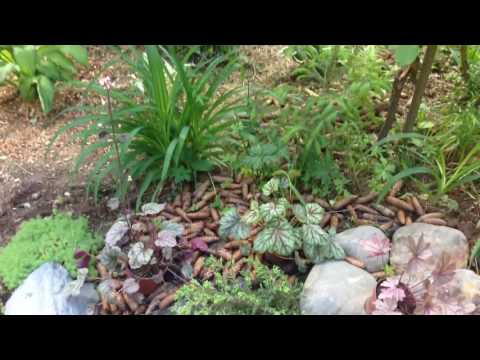

Watch this video on YouTube

